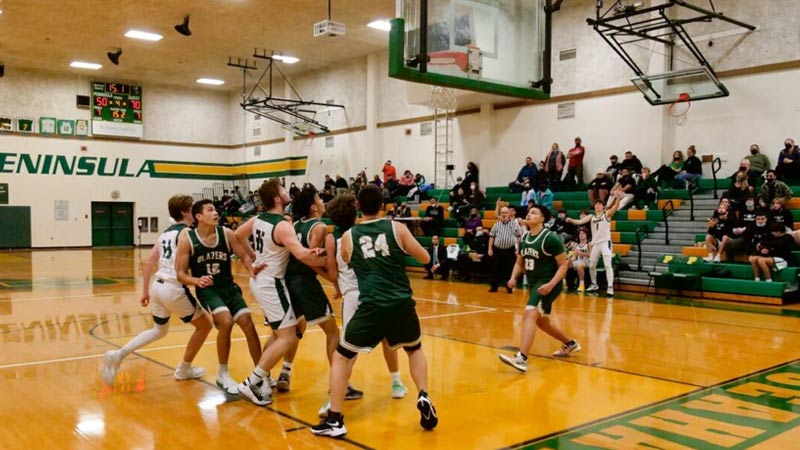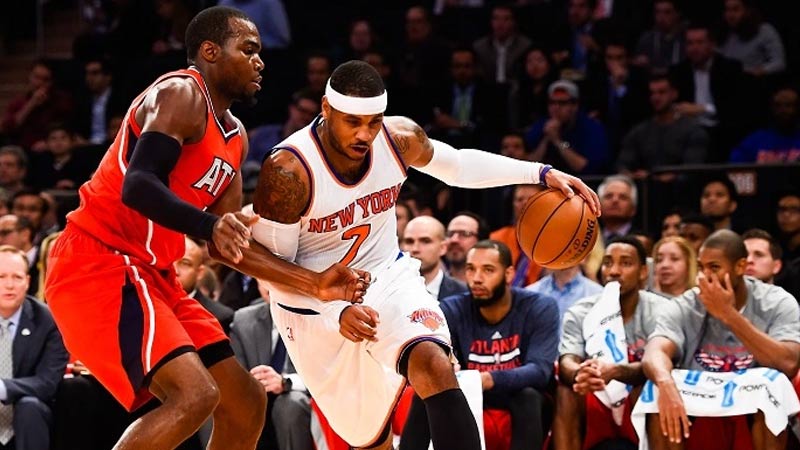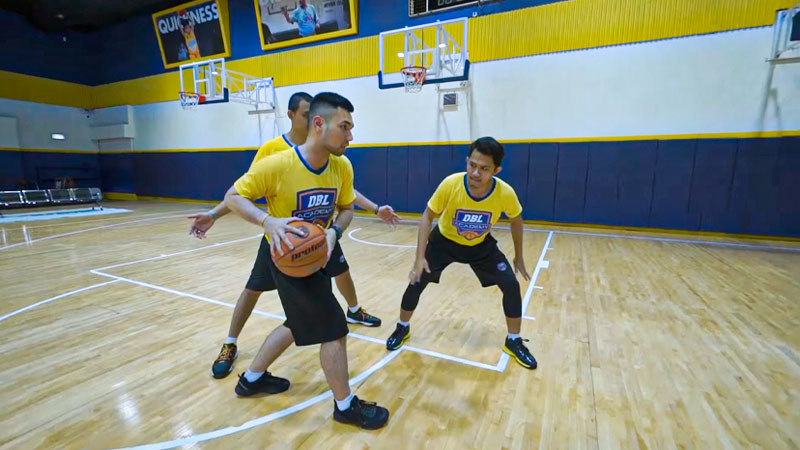In the world of basketball, teams constantly strive to develop effective defensive strategies to counter their opponents’ offensive prowess. One such strategy that has gained prominence is the Triangle Defense.
This defensive system takes its name from the geometric shape it forms on the court and focuses on strong positioning, communication, and disciplined rotations.
In this blog post, we will delve into the concept of Triangle Defense in basketball, exploring its key techniques, advantages, limitations, and its significance in the game. So, stay focused and read till the end.
What Is Triangle Defense in Basketball?
Triangle Defense in basketball is a defensive system that focuses on positioning, communication, and disciplined rotations to disrupt the opponent’s offense. It derives its name from the triangular shape formed by defenders on the court.
This defensive strategy has gained recognition for its effectiveness in limiting scoring opportunities and creating a cohesive defensive unit.
According to statistical analysis, teams employing the Triangle Defense have demonstrated improved defensive ratings, reduced opponent field goal percentages, and increased turnover rates.
The system emphasizes strong help-side defense, denial of passing lanes, and effective communication to execute rotations and cover for one another.
While it may have limitations and challenges, the Triangle Defense offers teams a strategic approach to defend against various offensive schemes, establishing a strong defensive identity and providing a competitive advantage.
Key Techniques and Strategies in the Triangle Defense

Source: teachhoops.com
The Triangle Defense, a renowned defensive system in basketball, employs several key techniques and strategies to stifle the opposing team’s offense. Let’s delve into some essential aspects of this defensive system:
Strong Help-Side Defense
The Triangle Defense places a strong emphasis on help-side defense. Players are strategically positioned to provide support and protect the paint, making it challenging for opponents to find easy driving lanes.
By positioning themselves correctly, defenders can effectively contest shots and deter opponents from attacking the basket.
Communication and Rotations
Effective communication and disciplined rotations are vital in Triangle Defense. Defenders must communicate with each other to ensure seamless switches and coverage.
As offensive players move and cut, defenders must rotate promptly to maintain defensive integrity and prevent open shots. This coordinated effort requires constant communication and awareness on the part of the defensive players.
Denial and Pressure
The Triangle Defense places an emphasis on denying easy passes and applying pressure on the ball. Defenders actively disrupt passing lanes by getting in the passing lanes, using active hands, and anticipating plays.
By denying the offense’s preferred passing options, the defense can disrupt the offensive flow, force rushed decisions, and create turnovers that lead to transition opportunities.
Defensive Rebounding
Rebounding is a critical component of the Triangle Defense. After forcing a missed shot, defenders must box out and secure defensive rebounds to limit the opponent’s second-chance opportunities.
By controlling the boards, the defense can effectively end the opponent’s possession and prevent additional scoring opportunities.
The Triangle Defense’s combination of strong help-side defense, communication, denial, pressure, and defensive rebounding makes it a formidable system for limiting the opposing team’s offensive effectiveness.
Advantages of the Triangle Defense

Source: heavy.com
The Triangle Defense offers several advantages that can greatly benefit a team. Some of the notable advantages include:
Strong Positioning
The Triangle Defense prioritizes positioning, meaning players are strategically placed on the court to limit the opponent’s scoring opportunities, particularly in the paint.
By maintaining proper positioning, the defense can prevent easy baskets and make it harder for opponents to find open shots. This increases the chances of getting stops and reduces the opponent’s overall scoring efficiency.
Communication and Teamwork
The Triangle Defense places a strong emphasis on effective communication and teamwork. Players must constantly communicate with each other to ensure proper rotations and coverage. They need to be aware of their teammates’ positions and movements to maintain defensive integrity.
This level of communication and teamwork fosters a cohesive defensive unit, where players are constantly supporting and covering for one another, making it difficult for the offense to exploit defensive gaps.
Disruptive Nature
One of the notable characteristics of the Triangle Defense is its disruptive nature. The defensive system employs active hands, quick rotations, and trapping techniques to disrupt offensive plays and create turnovers.
By applying pressure on the ball and denying passing lanes, the defense can force the offense into making mistakes, leading to steals, deflections, and shot clock violations.
These disruptive actions not only disrupt the opponent’s offensive flow but also provide transition scoring opportunities for the defending team.
Flexibility
The Triangle Defense is flexible and adaptable to different defensive personnel and offensive schemes.
It can be adjusted based on the opponent’s strengths and weaknesses, allowing teams to tailor their defensive strategies accordingly.
Whether facing a high-scoring perimeter-oriented team or a team with dominant post players, the Triangle Defense can be modified to account for these specific challenges.
This flexibility enables teams to effectively defend against a variety of offensive styles and adjust their approach throughout a game or series.
So, the Triangle Defense offers a combination of strong positioning, effective communication and teamwork, disruptive tactics, and flexibility, making it a versatile defensive system that can greatly benefit a team.
It not only limits the opponent’s scoring opportunities but also creates advantages for the defending team through turnovers and transition scoring.
Limitations and Challenges
While the Triangle Defense has its advantages, it also has limitations and challenges that teams need to consider. Some of these include:
Vulnerability to Outside Shooting
The emphasis on protecting the paint in the Triangle Defense can leave the perimeter vulnerable to outside shooting. Teams with strong outside shooters can exploit this weakness.
Defensive Communication
Effective communication is vital in the Triangle Defense. If communication breakdowns occur, defensive assignments can be missed, leading to open scoring opportunities for the opponent.
Athleticism and Speed
The Triangle Defense requires defenders to possess sufficient athleticism and speed to rotate and recover quickly. Teams with fewer athletic personnel may struggle to execute the system effectively.
Adaptability
While the Triangle Defense offers flexibility, it requires practice and familiarity for optimal execution. It may take time for players to fully grasp the rotations, communication, and positioning required.
Significance of Triangle Defense in Basketball
The significance of the Triangle Defense in basketball extends beyond its strategic approach. Here’s a deeper look into its importance:
Strategic Approach
The Triangle Defense offers teams a comprehensive and adaptable approach to defense. Its emphasis on positioning, rotations, and communication allows teams to counter a variety of offensive schemes effectively.
By understanding the principles of Triangle Defense, teams can make strategic adjustments during games and minimize their opponents’ scoring opportunities.
Team Unity
The Triangle Defense thrives on communication and teamwork. It requires players to trust each other, communicate effectively, and execute rotations seamlessly. This fosters a sense of unity and cohesion among teammates as they work together to protect the basket and disrupt the opponent’s offense.
Defensive Identity
Implementing the Triangle Defense can help teams establish a distinct defensive identity. It becomes a defining characteristic of their playing style, showcasing their discipline, coordination, and defensive prowess.
Developing a strong defensive identity can elevate a team’s performance and make them more formidable opponents.
Competitive Advantage
Mastering the Triangle Defense provides teams with a competitive advantage. By effectively executing the principles of the defense, teams can disrupt opposing offenses, limit scoring opportunities, and force turnovers.
This can shift the momentum of games, create fast-break opportunities, and ultimately contribute to a team’s overall success.
The significance of the Triangle Defense in basketball lies in its strategic approach, its ability to foster team unity, its potential to establish a defensive identity, and the competitive advantage it offers.
FAQs
How can teams effectively communicate in the Triangle Defense?
Teams in the Triangle Defense should prioritize open and constant communication. This includes calling out defensive assignments, signaling rotations, and providing updates on offensive player movement.
What are the key principles of positioning in the Triangle Defense?
The Triangle Defense emphasizes maintaining a strong help-side position, denying the middle of the paint, and closing out on shooters while remaining disciplined with rotations and switches.
Can the Triangle Defense be used at all levels of basketball?
Yes, the Triangle Defense can be used at all levels of basketball. However, the level of execution and effectiveness may vary depending on the skill level and familiarity of the players with the system.
How can teams overcome challenges with athleticism in the Triangle Defense?
Teams with less athleticism can compensate by focusing on sound positioning, anticipation, and communication. By playing smart and leveraging their defensive IQ, they can still effectively execute the principles of the Triangle Defense.
Can the Triangle Defense be combined with other defensive strategies?
Yes, teams can incorporate elements of the Triangle Defense into their overall defensive strategy.
It can be combined with other tactics such as zone defense or man-to-man principles to create a hybrid defensive system that suits the team’s strengths and the opponent’s weaknesses.
Bottom Line
The Triangle Defense offers teams a strategic and cohesive approach to defending in basketball.
Through its emphasis on positioning, communication, and disciplined rotations, it aims to disrupt opposing offenses, limit scoring opportunities, and create a unified defensive unit.
While it has its limitations and challenges, the Triangle Defense can be an effective tool in a team’s defensive arsenal.
By mastering its techniques and implementing them with precision, teams can gain a competitive edge and establish a strong defensive identity on the basketball court. Thank you.







